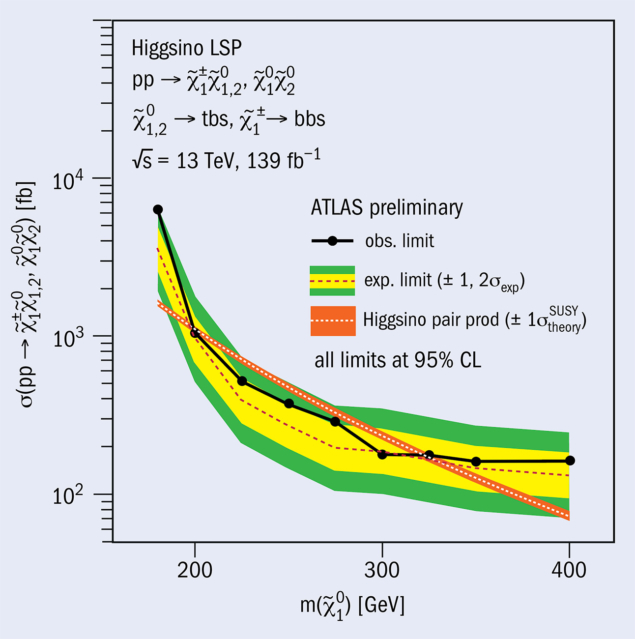A report from the ATLAS experiment

The Higgs boson was hypothesised to explain electroweak symmetry breaking nearly 50 years before its discovery. Its eventual discovery at the LHC took half a century of innovative accelerator and detector development, and extensive data analysis. Today, several outstanding questions in particle physics could be answered by higgsinos – theorised supersymmetric partners of an extended Higgs field. The higgsinos are a triplet of electroweak states, two neutral and one charged. If the lightest neutral state is stable, it can provide an explanation of astronomically observed dark matter. Furthermore, an intimate connection between higgsinos and the Higgs boson could explain why the mass of the Higgs boson is so much lighter than suggested by theoretical arguments. While higgsinos may not be much heavier than the Higgs boson, they would be produced more rarely and are significantly more challenging to find, especially if they are the only supersymmetric particles near the electroweak scale.
Higgsinos mix with other supersymmetric electroweak states, the wino and the bino, to form the physical particles that would be observed
The ATLAS collaboration recently released a set of results based on the full LHC Run 2 dataset that explore some of the most challenging experimental scenarios involving higgsinos. Each result tests different assumptions. Owing to quantum degeneracy, the higgsinos mix with other supersymmetric electroweak states, the wino and the bino, to form the physical particles that would be observed by the experiment. The mass difference between the lightest neutral and charged states, ∆m, depends on this mixing. Depending on the model assumptions, the phenomenology varies dramatically, requiring different analysis techniques and stimulating the development of new tools.
If ∆m is only a few hundred MeV, the small phase space suppresses the decay from the heavier states to the lightest one. The long-lived charged state flies partway through the inner tracker before decaying, and its short track can be measured. A search targeting this anomalous “disappearing track” signature was performed by exploiting novel requirements on the quality of the signal candidate and the ability of the ATLAS inner detectors to reconstruct short tracks. Finding that the number of short tracks is as expected from background processes alone, this search rules out higgsinos with lifetimes of a fraction of a nanosecond for masses up to 210 GeV.
If higgsinos mix somewhat with other supersymmetric electroweak states, they will decay promptly to the lightest stable higgsino and low-energy Standard Model particles. These soft decay products are extremely challenging to detect at the LHC, and ATLAS has performed several searches for events with two or three leptons to maximise the sensitivity to different values of ∆m. Each search features innovative optimisation and powerful discriminants to reject background. For the first time, ATLAS has performed a statistical combination of these searches, constraining higgsino masses to be larger than 150 GeV for ∆m above 2 GeV.
A final result targets higgsinos in models in which the lightest supersymmetric particle is not stable. In these scenarios, higgsinos may decay to triplets of quarks. A search designed around an adversarial neural network and employing a completely data-driven background estimation technique was developed to distinguish these rare decays from the overwhelming multi-jet background. This search is the first at the LHC to obtain sensitivity to this higgsino model, and rules out scenarios of the pair production of higgsinos with masses between 200 and 320 GeV (figure 1).
Together, these searches set significant constraints on higgsino masses, and for certain parameters provide the first extension of sensitivity since LEP. With the development of new techniques and more data to come, ATLAS will continue to seek higgsinos at higher masses, and to test other theoretical and experimental assumptions.
Further reading
ATLAS Collab. 2021 SUSY-2019-09.
ATLAS Collab. 2021 ATLAS-CONF-2021-007.
ATLAS Collab. 2021 ATLAS-CONF-2021-015.





